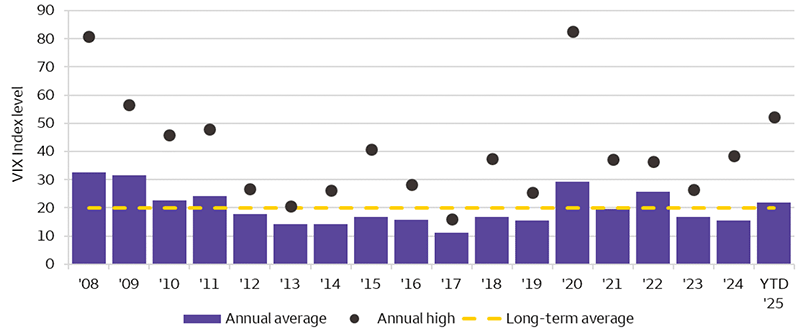May 6, 2025
Scott Wren, Senior Global Market Strategist
Focusing on quality amid stock-market volatility
 Sources: Bloomberg and Wells Fargo Investment Institute. Data from January 1, 2008, to April 30, 2025. YTD = year-to-date. The Chicago Board Options Exchange Volatility Index (VIX) is a key measure of market expectations of near-term volatility conveyed by S&P 500 Index option prices. An index is unmanaged and not available for direct investment. Past performance is no guarantee of future results. Excerpted from Market Commentary (April 30) and Market Charts (Q2 2025)
Sources: Bloomberg and Wells Fargo Investment Institute. Data from January 1, 2008, to April 30, 2025. YTD = year-to-date. The Chicago Board Options Exchange Volatility Index (VIX) is a key measure of market expectations of near-term volatility conveyed by S&P 500 Index option prices. An index is unmanaged and not available for direct investment. Past performance is no guarantee of future results. Excerpted from Market Commentary (April 30) and Market Charts (Q2 2025)Uncertainty likely to contribute to bouts of above-average volatility throughout 2025
Investors do not like uncertainty, but that’s what we have seen a heavy dose of in recent months. As the chart above shows, volatility so far this year (as represented by the VIX Index) has been well above the long-term average and a step above 2024’s average level. We expect that trend to continue as markets grapple with geopolitical, monetary policy, and economic growth uncertainties, which may contribute to bouts of above-average volatility throughout the year.
We keep getting the absolutely rational question: “Have we seen the bottom in stocks?” As much as we would like to boldly answer that question with a resounding “yes!” that just isn’t the case. Tariff and growth concerns are the main market drivers right now, but there will likely be a few other issues that result in road bumps in the months ahead. We wouldn’t be surprised if the S&P 500 Index retested its lows as additional uncertainties create headwinds.
What it may mean for investors
Against policy uncertainty, we favor focusing on quality. We would use the recent rebound to reallocate to our highest-rated asset classes, including U.S. Large Cap and Mid Cap Equities, and quality sectors that emphasize stable balance sheets and good cash flow, such as Information Technology, Communication Services, Financials, and Energy. Our view is that quality allocations should help preserve wealth and offer better growth opportunities as uncertainties finally fade.
Risk Considerations
Each asset class has its own risk and return characteristics. The level of risk associated with a particular investment or asset class generally correlates with the level of return the investment or asset class might achieve. Stock markets are volatile. Stock values may fluctuate in response to general economic and market conditions, the prospects of individual companies, and industry sectors. Mid-cap stocks are generally more volatile, subject to greater risks and are less liquid than large company stocks. Sector investing can be more volatile than investments that are broadly diversified over numerous sectors of the economy and will increase a portfolio’s vulnerability to any single economic, political, or regulatory development affecting the sector. This can result in greater price volatility.
Definitions
Chicago Board Options Exchange Volatility Index (VIX) is a key measure of market expectations of near-term volatility conveyed by S&P 500 Index option prices.
S&P 500 Index is a market capitalization-weighted index composed of 500 widely held common stocks that is generally considered representative of the U.S. stock market.
An index is unmanaged and not available for direct investment.
General Disclosures
Global Investment Strategy (GIS) is a division of Wells Fargo Investment Institute, Inc. (WFII). WFII is a registered investment adviser and wholly owned subsidiary of Wells Fargo Bank, N.A., a bank affiliate of Wells Fargo & Company.
The information in this report was prepared by Global Investment Strategy. Opinions represent GIS’ opinion as of the date of this report and are for general information purposes only and are not intended to predict or guarantee the future performance of any individual security, market sector or the markets generally. GIS does not undertake to advise you of any change in its opinions or the information contained in this report. Wells Fargo & Company affiliates may issue reports or have opinions that are inconsistent with, and reach different conclusions from, this report.
The information contained herein constitutes general information and is not directed to, designed for, or individually tailored to, any particular investor or potential investor. This report is not intended to be a client-specific suitability or best interest analysis or recommendation, an offer to participate in any investment, or a recommendation to buy, hold or sell securities. Do not use this report as the sole basis for investment decisions. Do not select an asset class or investment product based on performance alone. Consider all relevant information, including your existing portfolio, investment objectives, risk tolerance, liquidity needs and investment time horizon. The material contained herein has been prepared from sources and data we believe to be reliable but we make no guarantee to its accuracy or completeness.
Wells Fargo Advisors is registered with the U.S. Securities and Exchange Commission and the Financial Industry Regulatory Authority, but is not licensed or registered with any financial services regulatory authority outside of the U.S. Non-U.S. residents who maintain U.S.-based financial services account(s) with Wells Fargo Advisors may not be afforded certain protections conferred by legislation and regulations in their country of residence in respect of any investments, investment transactions or communications made with Wells Fargo Advisors.
Wells Fargo Advisors is a trade name used by Wells Fargo Clearing Services, LLC and Wells Fargo Advisors Financial Network, LLC, Members SIPC, separate registered broker-dealers and non-bank affiliates of Wells Fargo & Company.


